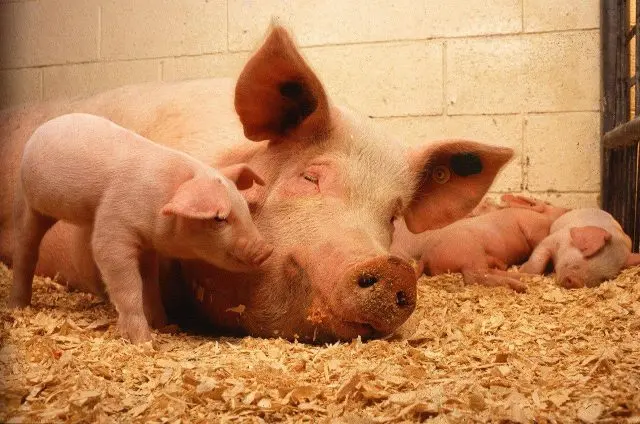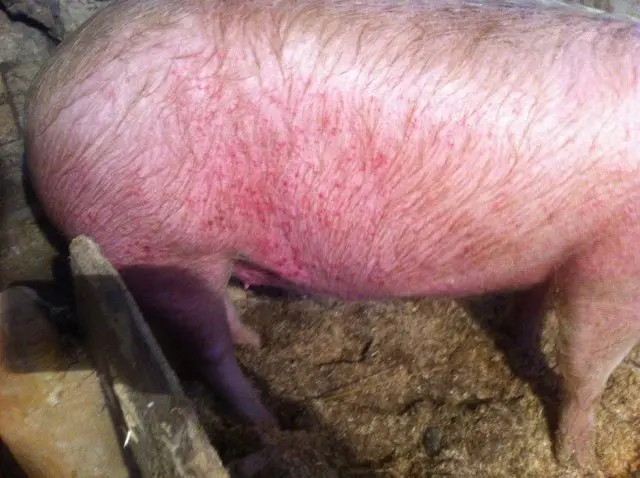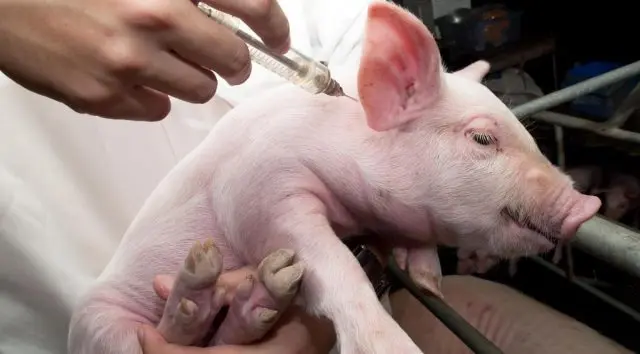Contents
- General characteristics of the disease
- Ways of infection
- Why parasites are dangerous for pigs
- Distribution and causes
- Symptoms of ascariasis in pigs
- Establishing diagnosis
- How to remove worms from pigs
- Treatment of worms in piglets
- A set of preventive measures
- Is it possible to eat meat if pigs have roundworms
- Conclusion
Ascariasis of pigs is considered a conditionally dangerous disease that affects the development and growth of piglets. In some cases, the death of young animals is possible, since their immunity may not be able to cope with the toxic effects of parasitic organisms.
General characteristics of the disease
The causative agent of the disease is roundworm Ascaris suum. They enter the body of the pig and continue to develop in the small intestine. Ascaris females are quite large – on average, 30 cm, and males reach a maximum height of 25 cm.
Parasite life cycle:
- Each female produces between 100 and 250 eggs.
- They leave the body of the pig along with the feces, and, once in a warm environment rich in water and oxygen, the eggs begin invasive development. This stage lasts up to 4 weeks.
- If the roundworm egg at the stage of invasive development enters the body of a pig along with water or food, then parasitic larvae appear in the intestines of the animal.
- From the digestive tract, they pass into the liver of the pig.
- After some time, the larvae are sent to the right atrium of the pig.
- Then they enter the lungs.
- During coughing, the pig swallows the larvae along with the mucus.
- Once in the pig’s body again, the roundworm begins to grow: this is how pig ascariasis develops.

Ways of infection
The main source of infection of a pig with ascariasis are sick individuals and their places of residence. Since parasite eggs have high levels of resistance to external environmental factors, they can remain in the soil for about 3 years without dying in the hot season and even with frosts of -30 oC. The main causes of ascariasis in pigs include the following:
- the use of pig feed with roundworm eggs;
- sucking milk from a mother who has parasite eggs on her skin;
- eating contaminated soil (pigs eat it with a lack of minerals in the feed);
- unsanitary conditions for keeping pigs;
- eating earthworms, which are carriers of parasite larvae;
- the presence in the environment of a large number of beetles, flies and other insects, which are a reservoir and source of invasion;
- infection of piglets with worms in the womb;
- insufficient methods of prevention, as well as neighborhood with sick pigs.
Why parasites are dangerous for pigs
Ascariasis is especially dangerous for young pigs: with age, the threat of infection decreases. Young animals, whose age is 3-5 months (gilts and weaners), suffer especially strongly.
Dangerous consequences of infection of pigs with ascaris:
- hemorrhage: occurs due to the migration of larvae throughout the body. During the movement of roundworms through the tissues and organs of the piglet, small vessels are damaged;
- inflammatory processes;
- pig intoxication: larvae, living in the body of pigs, can not only excrete their waste products, but also die, which negatively affects the animal’s immune system;
- allergy to metabolic products of larvae;
- damage to the intestinal mucosa of the pig;
- blockage of the gastrointestinal tract and its rupture, followed by the death of the pig;
- obstruction of the outflow of bile: in the case when the parasite enters the bile duct;
- ascariasis pneumonia: occurs in young pigs with severe infection.
Distribution and causes
Ascariasis of pigs is a disease that has no boundaries. Parasite larvae can live in almost any environment, so there is no territorial division into dangerous and safe regions. The only difference is that in areas with a humid and warm climate, the risk of infection with ascariasis in piglets is all year round. Regions with a more severe climate are less vulnerable, but the peak of the spread of ascariasis occurs in the spring and summer months. Roundworm is most common in regions where pig farming is large-scale, as well as in tropical zones and countries with a low standard of living.
Ascariasis statistics.
Countries | Percentage of infected pigs with ascariasis (of the total population) |
Southeast Asia | 55 – 65% |
Africa | 50 – 60% |
European countries | 30 – 35% |
Canada | 60% |
Federation | 30 – 35% |
The main reasons for the development of ascariasis in piglets include the following factors:
- beriberi: that is why in countries where there is no financial opportunity to introduce special additives into pig feed, the number of infected animals has a high percentage;
- poor care, violation of the rules for keeping piglets;
- unbalanced nutrition, in which the piglet does not receive the right amount of minerals and carotene;
- dampness in pigsties and high levels of air humidity;
- purchase of feed in areas where there is an increased level of roundworm infestation.
Symptoms of ascariasis in pigs
Every owner of piglets should be aware of the signs of worms in pigs, since the health of the livestock and even life depends on this. The clinical picture depends entirely on the stage of development of the larvae that have entered the body. It is customary to divide the degree of infection into two forms:
- chronic (intestinal or imaginal) – adult worms reproduce in the body;
- acute (pulmonary, laurel, migratory) – develops in the initial period of migration of larvae through the body of a piglet.
Symptoms of acute ascariasis in pigs:
- dyspnea;
- breathing difficult, hoarse;
- the presence of bronchogenic pneumonia and bronchitis, which are manifested by a dry cough of a piglet, as well as a cough, in which there is a release of purulent and mucous sputum;
- increase in body temperature – up to 41 – 42 oC;
- convulsions and paresis;
- anxiety, behavior of a piglet, similar to fright;
- vomiting;
- manifestation of allergic reactions;
- cyanosis of the mucous membranes;
- reddening of the skin, accompanied by short convulsions of the pig (no more than 1 minute);
- increased breathing;
- gnashing of teeth;
- edema of the intermaxillary region and eyelids of a piglet.
Symptoms of chronic ascariasis of pigs:
- loss of young interest in food;
- constipation that alternates with diarrhea;
- presence of signs of gastroenteritis;
- weight loss;
- growth retardation of the pig.
In the absence of effective therapy for worms, anorexia, anemia, intoxication and eosinophilia develop, which can lead to the death of a piglet.

Signs of worms in piglets
Small piglets, which are at greater risk of infection with roundworms, are more difficult to tolerate the development of worms in their bodies. To the above symptoms, which are characteristic of all ages of the animal, you can add the following signs that are characteristic of young pigs:
- trembling of the belly and limbs (observed in gilts);
- desire to lie on one side, rapid fatigue;
- uncoordinated movements;
- jaundice;
- pneumonia;
- feces with an admixture of blood or painted black;
- separation of saliva in large quantities;
- the desire of the piglet to hide (dig in) in the litter;
- rashes, manifested in the form of flat papules, which disappear after a few days, and dark stripes remain in their place.
These symptoms should be of greatest concern to owners of three-month-old piglets.
Establishing diagnosis
Diagnosis of ascariasis in piglets is carried out in various ways, each of which has its own pros and cons.
Methods for diagnosing ascariasis | Advantages | Disadvantages |
Fulleborn method | Parasite eggs float on the surface of a saturated saline solution. The method is affordable. | Eggs float slowly. |
Shcherbovich’s method | Feces taken for testing are diluted in a mixture of mineral salts. They are sent to a centrifuge, where eggs are detected under a microscope. The method is highly reliable. | The procedure is long and expensive in terms of equipment. |
Berman-Orlov method | Fresh feces are precipitated, previously dissolved in water. Examine the results under a microscope. The method is accurate and reliable. | The analysis requires special equipment. |
Kalantarian method | Stool samples are mixed with NaNO solution3. Accurate and affordable method. | Eggs of parasites float rather slowly. |
Darling method | Centrifugation of feces. The method is simple and efficient. | It takes a lot of time to prepare the sample. |
How to remove worms from pigs
Each owner should know not only about the symptoms of worms in piglets, but also about the methods of treatment at home. The further condition of the piglet depends on how effective measures are taken at an early stage of the disease and at the first detection of signs of infection.
Deworming medicines for pigs
There are many preparations for worms for pigs, which are prescribed only after consultation with a specialist and are selected based on the stage of development of helminths. Most often, the following remedies for worms are prescribed:
Anthelmintic drug | Mode of application | Dosage in mg/kg body weight |
Aversect-2 | Injections | 0,3 |
It would be great | Subcutaneous injections | 0,3 |
Ivomek | Subcutaneous injections | 0,3 |
Ivomek-premix | Subcutaneous injections | 0,1 |
Fenbendazole | Feed additive | 10,0 |
Pirantel | Feed additive | 12,5 |
Tetramizole | Feed additive | 7,0 |
Piperazine | Feed additive | 300,0 |
Nilferm | Feed additive | 7,0 |
Deworming shots for pigs are not always the most effective. In some cases, a feed supplement applied for only 2 days is the most practical.
During treatment, piglets must be placed in separate rooms with concrete floors. Cleaning of the premises and processing of inventory with alkaline solutions should also be carried out regularly. If there are vegetables in the diet of pigs, then they must be subjected to heat treatment.
Folk remedies for worms in pigs
In addition to tablets for worms, folk remedies are also used for pigs, which are also very effective.
- garlic – add to the food of a piglet at the rate of 1 g per 1 kg of animal;
- a mixture of garlic and tansy flowers in a ratio of 1: 1 at the rate of 1 g of the mixture per 1 kg of live weight;
- raw pumpkin – it is fed to adult pigs in an unboiled form;
- beet tops – fresh, as a single feeding;
- brine from cabbage, tomatoes and cucumbers – added to porridge or drinking a piglet.
Treatment of worms in piglets
Small piglets from worms are best given drugs with a more gentle effect. The veterinarian should choose them, prescribing the necessary, and most importantly, safe dosage.
Medicines for worms in piglets
Most often, experts prescribe the following medicines to piglets:
- 10% albendazole – granular powder for worms for pigs is used per 1 kg of live weight 100;
- albino;
- fenbendazole;
- invermectin;
- preparations with iodine.
Treatment of piglets from worms with folk remedies
Young animals, which are most susceptible to infection due to a weak immune system, can also be recommended to use folk remedies:
- tansy flowers – 1 tsp powder 1 time per day with food;
- pumpkin porridge;
- decoction of pumpkin seeds.

A set of preventive measures
The negative consequences that worms cause in pigs can be seen in the photo. To prevent their occurrence and development, it is best to take a number of preventive measures. The main rule that all pig breeders should remember is: newly acquired pigs must be placed in a separate room (quarantine), where they are examined for the presence of all helminths, including ascaris.
As a preventive measure for the development of ascariasis in pigs, it is necessary:
- daily clean the manure in the pigsty;
- follow the rules of farrowing;
- create comfortable conditions for newly farrowed pigs that meet sanitary standards;
- regularly rinse all inventory with a solution of soda ash (piglet feeders, pig drinkers, etc.);
- maintain a proper diet;
- carry out timely deworming of pigs;
- organize visits by animals to a veterinarian for routine examinations;
- separate walking and maintenance of sexually mature pigs and young animals;
- carry out the burning of manure obtained due to the vital activity of infected pigs;
- annually plow up walking for pigs (hold an event in the autumn);
- eliminate factors contributing to the development of the disease (increased level of air humidity, high temperature, lack of natural ventilation in the room where pigs are kept).
Is it possible to eat meat if pigs have roundworms
If piglets are not given worm injections or tablets in a timely manner, then there is a risk that the slaughtered pig will be infected with ascariasis. When eating meat containing parasite larvae, there is a high risk of infection with human worms.
Due to the fact that adult worms and larvae of ascaris in pork can remain viable for a long time, the consumption of infected meat is possible only after thorough heat treatment. Before eating pork, it must be fried, boiled or stewed at a temperature of at least 70 oC, only under this condition piglet meat can be considered safe for consumption.
Conclusion
Ascariasis of pigs is easier to prevent than to cure. Therefore, it is important to follow the recommendations for the care of animals and not violate the schedule of vaccination of piglets against worms.









